It's easy to ferment your own grape leaves at home, and I've done it for years. Read on and I'll explain how to make the best pickled grape leaves you'll ever taste.
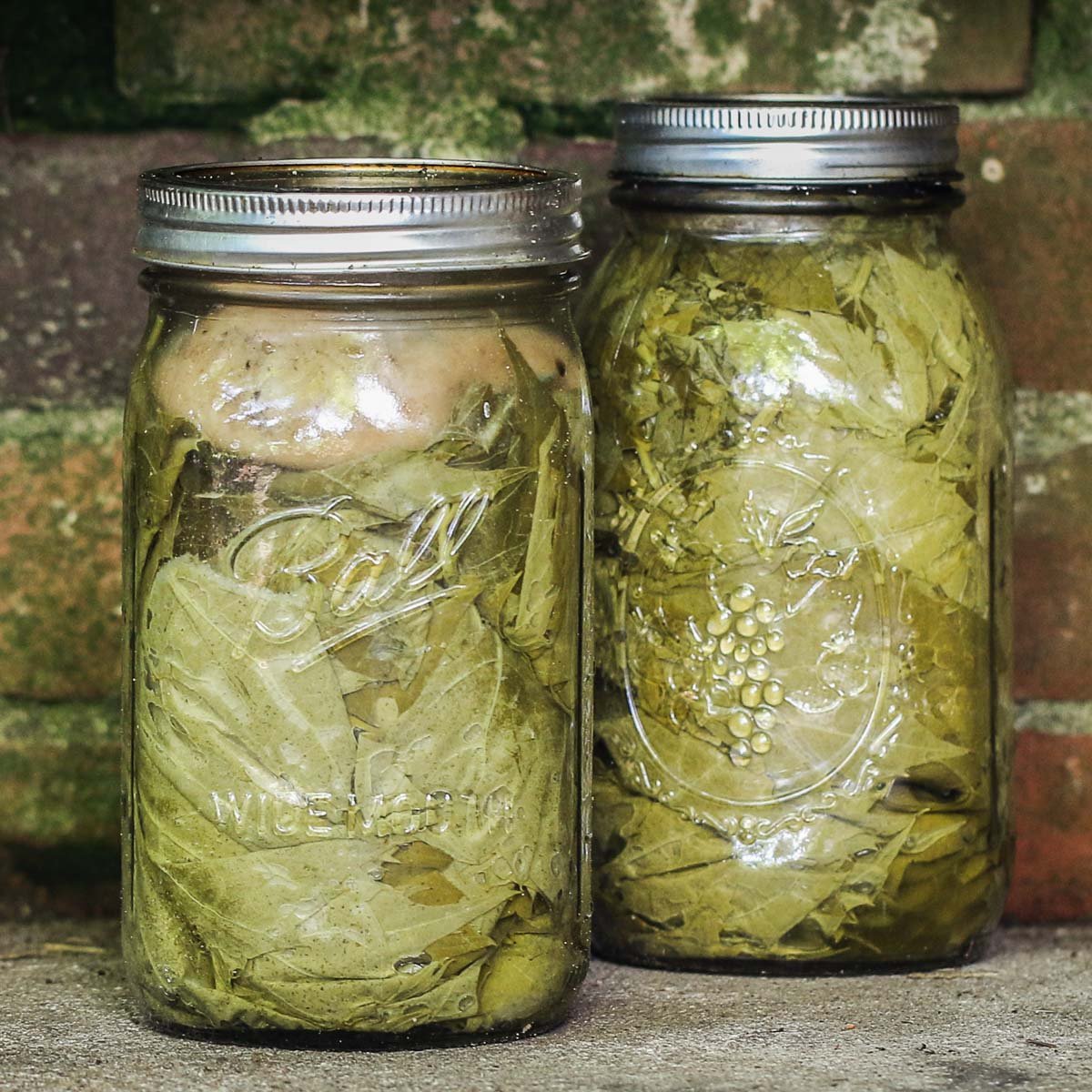
Have you ever had commercially pickled grape leaves? If you haven't, don't bother, I'm pretty sure they're the reason some people claim not to like grape leaves, or things made with them like dolmades.
Like plenty of commercial pickled things, I usually find grape leaves from a store shelf overly acidic, like the processor is trying to assassinate the grape leaves with vinegar. This pickled grape leaf recipe is the original one, and an ancient tradition you need to try if you have access to fresh grape leaves.
Sure, you could rinse or soak them, but, it's just not the same. If the companies that sell pickled grape leaves would go back to the old way, lacto-fermenting grape leaves with salt and water, I think a lot of people would enjoy them more. Fresh or frozen can work too, but there's something nice about having a few witchy jars around at the ready.
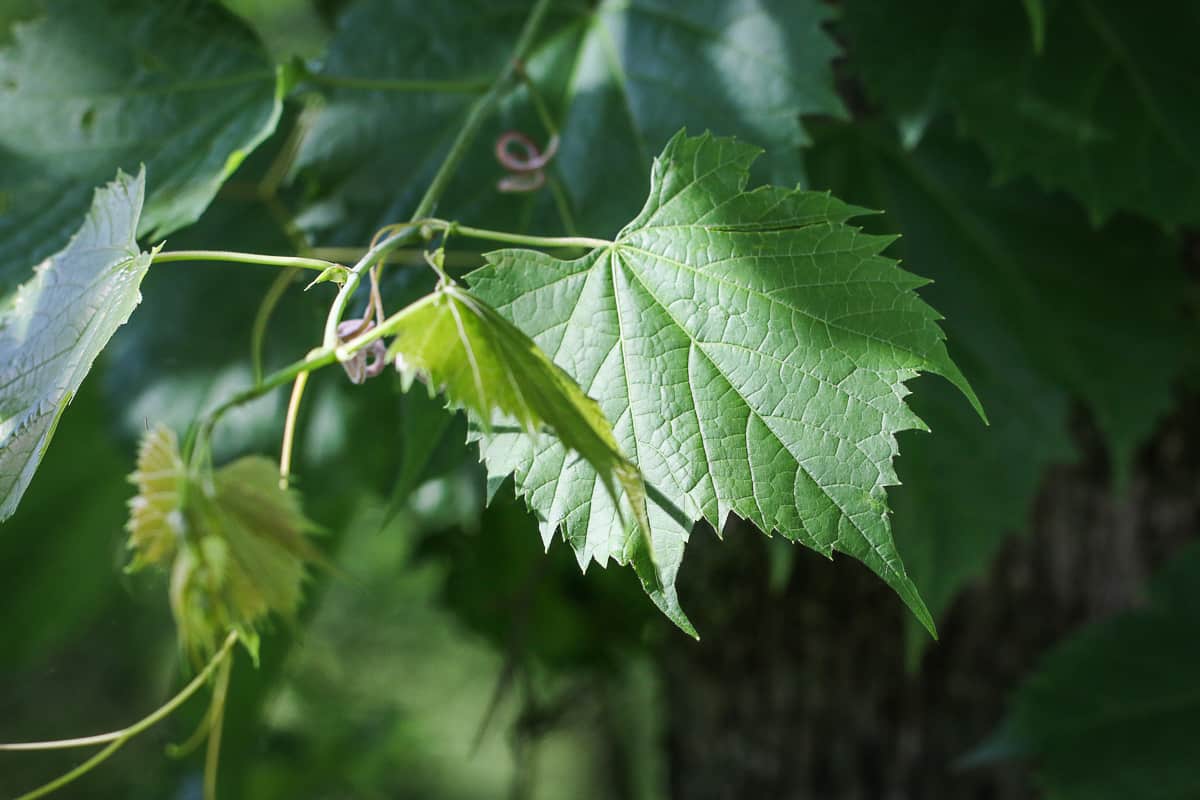
Naturally fermented grape leaves are one of the easiest projects I make this time of year, and the leaves are just prime for picking right now. They seem to be just about everywhere I go, and I'm lucky enough to have some right in the backyard about the size of a dinner plate. Absolutely huge.
As a bonus, picking grape leaves is a great reminder for me to check on the vines that I should come back to in about a month or two to pick wild grapes, the jelly they make being one of the best there is.
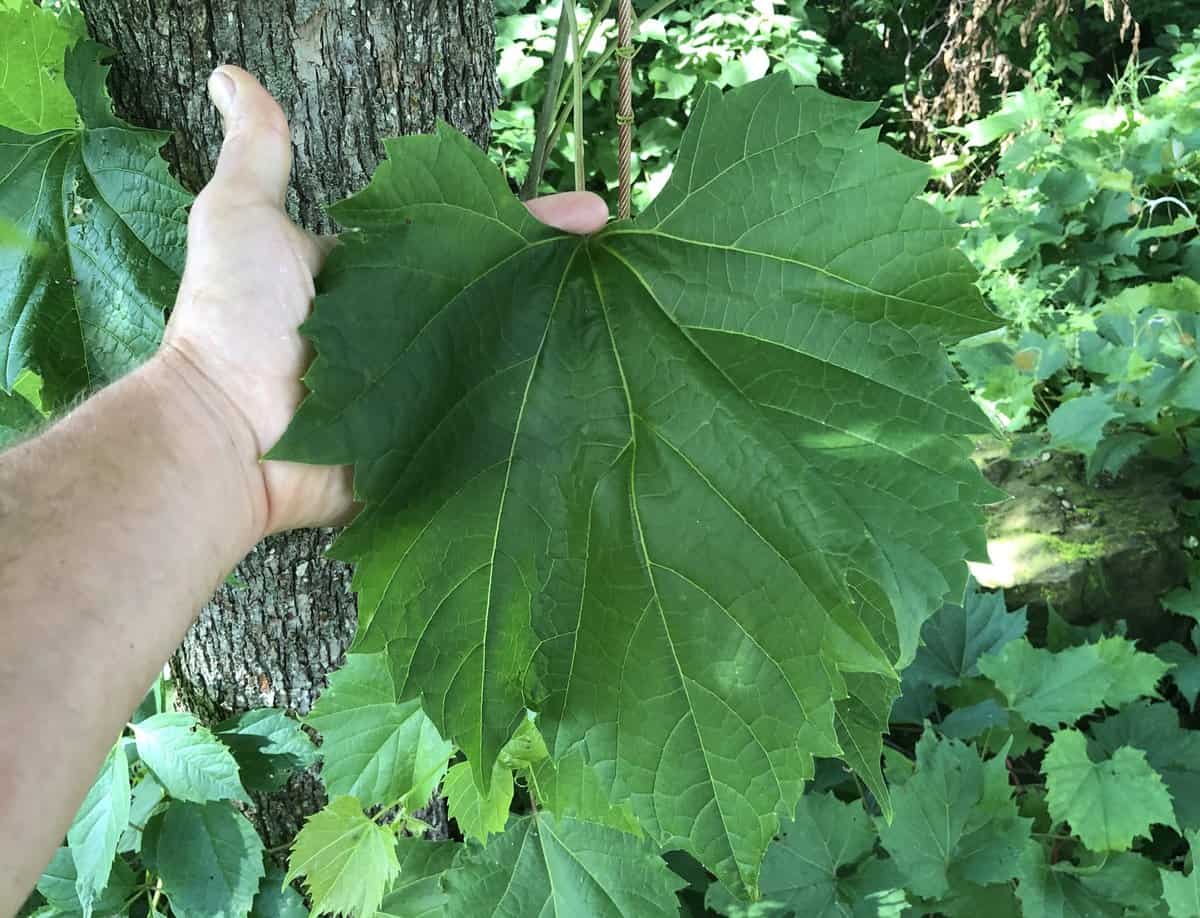
Stuffed, fermented grape leaves make such a good portable, easy-to-transport appetizer, this year I'd planned to serve some at the Midwest Wild Harvest Fest.
Unfortunately (and rightly so) the festival's been cancelled. The good news is, it gave me a chance to perfect my technique on the grape leaves. I tell you what, the amount of leaves you can fit into a quart jar is really impressive. I fit at least 100 big grape leaves in each one, which means that two humble quart jars of leaves will be enough to make a small appetizer for roughly 170 people in 2021. That's a good yield.
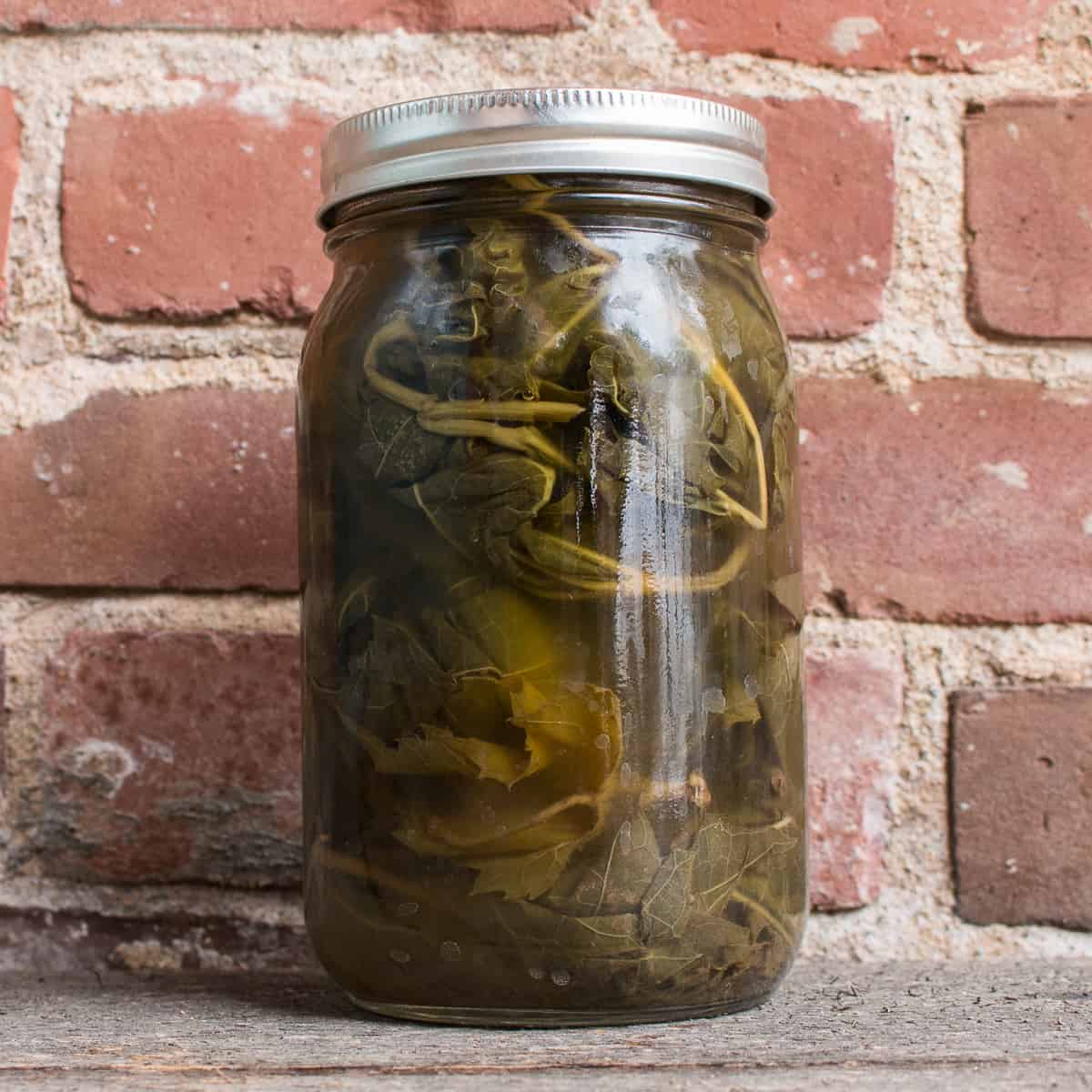
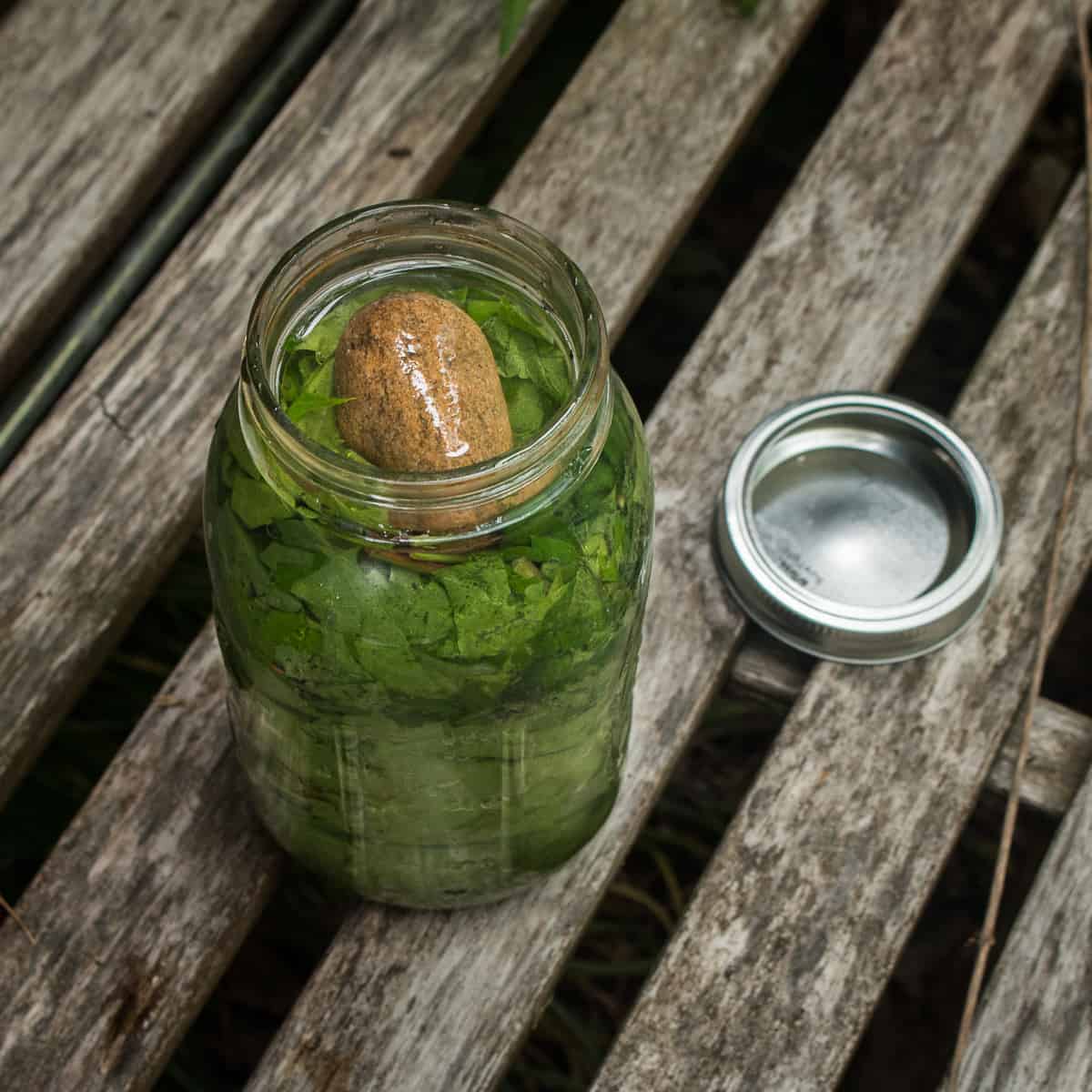
The key: removing stems and packing leaves in tight
The key to the recipe, if it can even be called that, is packing the leaves on top of each other and removing any stems that take up valuable real estate (see my improper technique from 2016 above).
Afterword, you wrap a handful of leaves up in a packet, stuff them in the jar, eventually helping them keep their place by stuffing in another pack of rolled leaves. After the jar is stuffed, I put a clean stone in the top, add water to cover, and add the salt, either 3% of the total weight of water and leaves, or 1.75 tablespoons per quart jar. From there, they sit outside and do their thing until I need them.
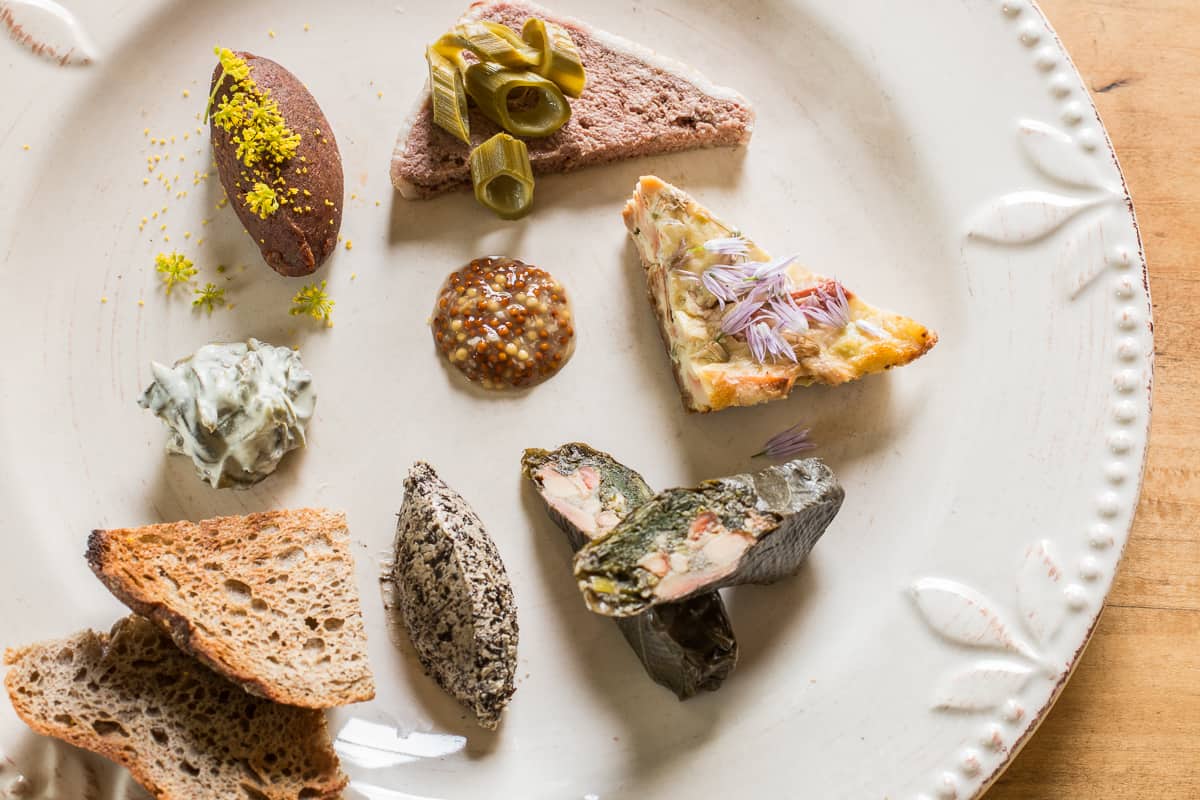
After the fermentation stops at about 2 weeks, the pH has plummeted so the leaves are shelf stable and don't need to be refrigerated. From there, you can take them out of the jar and use them whenever. They're a great thing to have around, especially in the summer when I crave eating cold, pre-prepared vegetable sides and snacks.
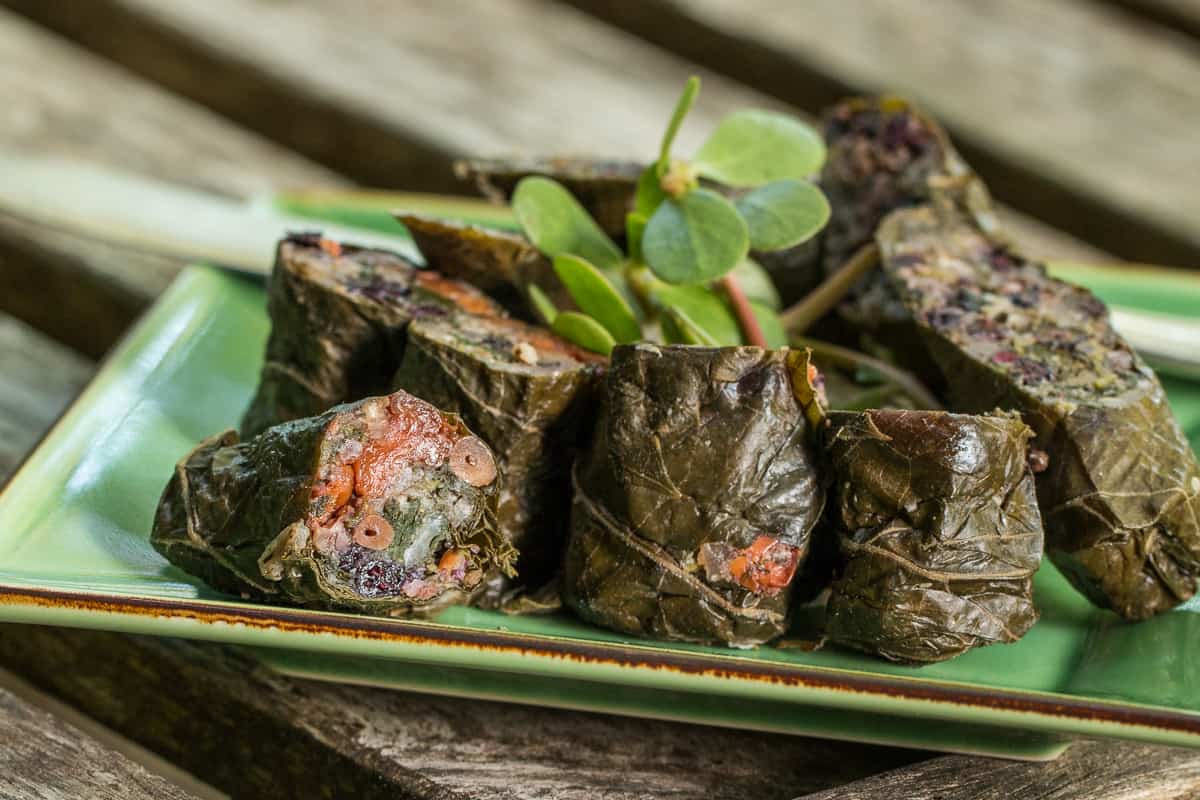
Fermented Grape Leaves
Equipment
- 1 qt mason jar, a small clean stone
Ingredients
- Fresh grape leaves, as needed large, clean leaves without bug holes and damage
- 1 Tablespoon Pickling salt you can sub kosher salt, sea salt, or another salt you like, preferably ground fine for easy dissolving. Use 1 Tablespoon salt per wide mouth quart jar.
- Filtered Water as nneded
Instructions
Harvesting
- When harvesting the grape leaves, be mindful to remove them at the stem so all you have is leaf. Choose clean grape leaves without any foreign matter on them (bird poo, insect eggs, spider webs, etc).
- Make a stack of grape leaves in your palm until it gets large, then fold them firmly into a roll or packet and stuff them into a quart jar.
- Repeat this process, stuffing the jar full until the jar is ¾ full. Put a clean stone on top to hold the leaves in place, then cover completely with water.
Make the brine
- Pour out the water, mix with the salt to dissolve, then pour back in the jar. (You can also just pour the salt into the jar and shake it, but it takes longer to dissolve.)
- For a more exact ferment using a scale, see note below.
2 Week Fermentation
- Put the jar(s) on a cookie sheet or other small tray to catch any brine that may migrate out and allow to ferment at room temperature.
- Open the jar occasionally to allow carbon dioxide to escape.
- Ferment the leaves for 1-2 weeks, depending on your taste. Store the jars in a place out of direct sun with a stable temperature, such as a pantry.
- Finished fermented grape leaves can be stored, always underneath their liquid, in their jar at room temperature, or they can be water bath canned and stored in a pantry. You can also keep them in the refrigerator where they will last near indefinitely, and don't run the risk of developing pesky kahm yeast.
Cooking with your leaves
- Your home-fermented grape leaves will be less salty and tart than commercial grape leaves stored in vinegar brine. But, if you want, you can rinse them before using them to make grape leaf rolls, etc.
Video
Notes
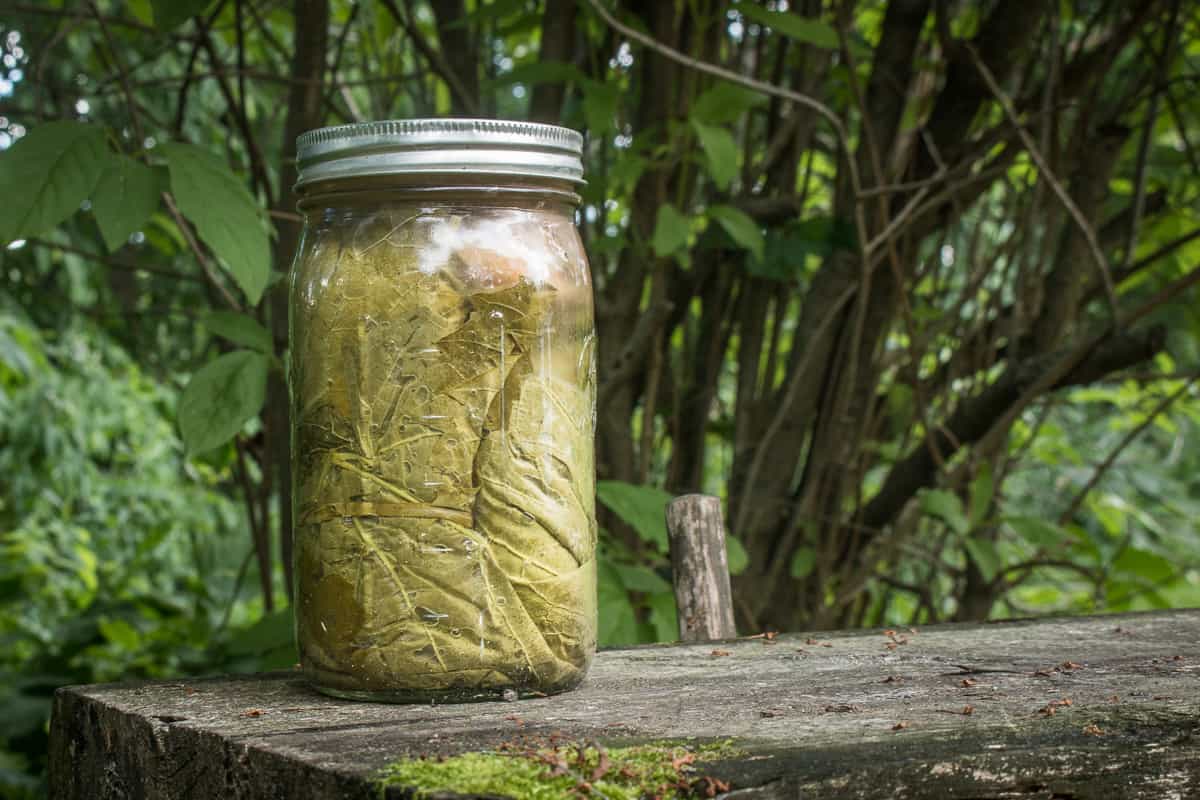

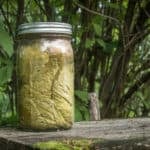
Vivian
My backyard is crawling with wild grape vines. I just freed a poor little bent dogwood that was almost immersed in vines. So I was hoping to try this on the leaves from my backyard. The problem was the instruction to use leaves "without bug holes or damage." I found none like that! All the leaves had at least tiny holes. I'm wondering why others can find better leaves than I can. Do I have more bugs in my yard?
What if a leaf has little skeletonized bits? They look like tiny white spots on the leaf. Is it OK to use those?
Alan Bergo
Go to a place where the leaves are better-they've everywhere and easy to find. The leaves in my backyard are shot too, but in other places they're perfect. Holes will make the stuffing fall out and are unsightly.
Charlotte
Hi Alan, thanks for the simple and delicious a looking recipe, I will try it in the summer. I've been lactic ferment among foods for nearly 10 years
However, I stopped doing ferments so regularly after my son was born as I became much more concerned about potential health risks. Thanks for sharing the 3% rule for the salt and the advice to water-bath the jars.
What if you sterilise the jars beforehand, would you still need to water-bath them in boiling water? And how do you avoid cooking the leaves and killing the lactobacillus?
One more question - I have a White Mulberry tree and am considering lactic fermenting the leaves, do you have any experience with this?
Thanks so much:)
Alan Bergo
Hi Charlotte. The fermentation is a preservation method here-the leaves are always cooked to serve them as they would be tough. If people want to consume raw lactobasilis I recommend they make curtido or fermented slaws that are designed to be consumed raw. If you sterilise the jars beforehand you likely don't need to water bath can them-but as that isn't as fool proof and can open the door to user error I don't list it explicitly. As for the mulberry trees, I've been meaning to do those too. Thimbleberry leaves can be used the same way, but they're stinky.
Kelly Chadwick
Hi. When you reference storing the grape leaves after they are finished fermenting, what's the difference about how they are stored, if not refrigerated?
Also, noticed I think you forgot to say to subtract the weight of empty jar from full jar before multiplying.
Thanks,
Kelly
Alan Bergo
Thanks Kelly, I adjusted that. This recipe is so simple it's complicated. You can store the jars at room temp, but it's better to water bath process them to ward off Kahm yeast.
shelly
i did the recipe. after 2 weeks. my brine is still crystal clear and the leaves are still the color as when i first placed them in the jar.... there are bubbles, but i can't tell if it's from when i packed them or from carbon off gassing. when i went to do my daily burping, it only sounded off gassy the first couple days and none since then. are they safe? should i taste the brine? thanks.
Alan Bergo
As long as you see bubbles you're good. Variations in temp, etc will give some variation.
Ian
Love this method-- much better than the more common pickled recipes you see all over the place.
One of my farmers gifted me with a very large batch of black currant leaves that she harvested, and after infusing some for vinegars, oils & syrups I'm wondering if this method could be adapted for them.
In your experience, would whole black currant leaf work if fermented in this grape leaf method?
Alan Bergo
Glad it worked for you Ian. I can't speak to currant leaves beyond using them to keep pickles crisp.
Taissa Decyk
Hello there! I live in Central Florida and have an immense amount of wild grape vines growing in my backyard (as well as other wonderful wild edibles!) I'm very excited to try this.
However, I'm wondering where exactly do I let them sit? Direct sunlight, indirect, shade? Inside or outside? Warm or cool?
Thank you!
Alan Bergo
Taissa, I adjusted the recipe a bit to make it more clear. Let me know if it makes sense. Alan
BECKY ELLEN CHARNESKIE
I am so excited!!!!!! I can’t wait for the spring!
Alan Bergo
Be excited. They're so good!!
Bonny Renner
Just made these for the first time following your 3% brine process and I will definitely be making them again. Thanks for sharing!
Victoria Cantwell
I have another batch that has been sitting for two weeks now...how do I know they are ready? Color? Once done, do I take the stone out, or leave it in the jar? I read that it is safe to store in brine on the shelf?
Thanks for the recipe, and help!
Alan Bergo
You know they're ready as they'll be tart, tasting of Lactobasilii (it's the same bacteria that make sauerkraut) also the color will be off-green. Bubbles are also an indication it is fermenting, but after two weeks the bubbling will slow down. Yes, it's fine to store these on the shelf. You can take the stone out if you like, or use it to weight them down. If I plan on storing them for an extended time I might can them in a water bath.
Victoria Cantwell
I just fermented grape leaves from my property. I took the stone out once finished...one outer leave had a black stain. Could that be from the stone sitting on it? The brine bubbles, the leaves are a light green. Is there any chance of it being a bad batch? I just want to be sure it is safe to cook with...
First tine fermenting.
Thanks!
Alan Bergo
Victoria. First, congratulations on attempting your first ferment. The black leaf is probably due to it coming into contact with air, discard that leaf. As the mixture ferments and bubbles, things can rise up, so you need to continually press things down to ensure they’re underneath brine. All the light green leaves should be fine. Once you do it a few times, you’ll get the hang of it.
Victoria Cantwell
Thanks! I just picked a bunch more, and am trying again! I had left the jar out 2 weeks, so a bit nervous using them although they do look fine.
I did have a rock on it, but will pay closer attention to it. There is something a out the word “botulism”, that had me worried I may have messed it up.
The liquid did still bubble, but was not cloudy, as I have read in other Posts.
Also, I did release the metal lid every so often, to let air out...does it matter the type of lid? I plan on sharing with my family, and definitely want to be safe...
Thanks for the great recipe, and quick response! Love your site!
Edith Cayanan
I heard from mg sisters-in-law that she used grape leaves. I’m not familiar with that. So I search and I found you. I have one tree at my backyard. And a lot of leaves, now I know what I’m going to do with the leaves. Thanks
Wren
Thank you so much for the encouragement to just get up and do this. I have stuffed tons of fresh grape leaves, but I have just not gotten around to preserving them for the winter. Which is a lame reason that I regret when the snow starts to fly and I wonder what I was doing all summer.
I have noticed, at least in my area, that the grapes grown in deep shade are often much more plate-like than then deeply-lobed leaves that I pass over at the forest's edge. Like dandelions, I imagine they're favoring maximizing surface area production so that they can get as much dappled sunlight as possible. Anyway! Thanks again for a great inspiration. Off I go to the shadiest side of the ravine...
Juleigh A Norwood
Thanks so much for the recipe. Everyone else seems to say they must be kept in the fridge, I have too many jars of lacto ferment in there already. I never fridge my kraut, I let it do its thing on the counter in the dark and eat it from there after 28 days. Are you saying that you let these sit and ferment outside in the sun for 2 weeks, then they can be stored for a year on the shelf?
Alan Bergo
If you store them on the shelf I would boil the brine and pour it over the greens, turn the jars upside down to seal from the heat, or waterbath can them. But yes, I've stored these for over a year with no loss of quality. Absolutely no refrigeration required.
Randall Thompson
Can you ferment cabbage this way, too?
Alan Bergo
Yes you could, but it's not necessary since cabbage already contains a lot of water.
pete hautman
Thanks for this, Alan. I use a lot of grape leaves. I usually stack and freeze them, then make dolmas throughout the year. I really like this fermenting approach and will be gathering leaves tomorrow! My back yard is loaded with them, and they are perfect right now.
Joe Wiercinski
I'm not sure why the subject of grape leaves appeals to me but it does. Grape leaves as food is more Mediterranean than Polish. My grandmother used them to line crocks that she filled with dill pickles she fermented in the cellar at our farm. A friend with Lebanese family roots, once gave me some grape leaves his aunts/grandmother/wife had stuffed with ground lamb. Delicious!! There are too damn many homecrafts from the past to make us feel nostalgic and we'll never do all of them, will we?. And yet, someday
Pam Trenholm
Interesting about lining the crock with grape leaves when doing the pickles that way. An old lady told me once, years ago, to always fold a grape leaf over each jar of dills before filling with the boiling dill brine. Sooo, I have always done that 🙂
Libby Baker
We always make dill pickles with a wild grape leaf tucked in. passed down from at least my great grandmother's time they stay crisper with them, i was told. I love brining grape leaves. I also like to chew on the little tendrils, as they are tangy. I wonder if adding some to the jars would add a nice flavor.
Alan Bergo
The tendrils are one of my favorite parts of the plant. They could be brined all by themselves but it's a lot of work for a small bite.
Pam Trenholm
Is the water boiling as it is added to the jar?
Alan Bergo
If you want to pack them hot and turn upside down to can without boiling in a water bath, yes. This concentrates the pressure made from the water and heat and forces the jars to hermetically seal without having to undergo boiling in water. Since the pH is so low that you could literally preserve something in the grape leaf brine, botulism is a non-issue.
Bill McDuff
Alan, Thanks for the recipe and post. We have lots of wild grapes in our local parks so I'll be giving this a try. A little trick I use when prepared solution for fermenting is to put the salt in a jar and boil some water stir until desolved and then add to the jar with the ingredients when it has cooled down.
Alan Bergo
Great tip!
Judy Johnson
Can you use wild grape leaves or just domesticated?
Alan Bergo
Any grape leaf will work, but for the wild species I know near you I prefer Vitis riparia to aestevalis as the latter has larger grooves that make the leaf look lobed, which means stuffing can easily fall out.
Stephen Linne
How long and at what temp to water bath can? For dill pickles they are now recommending 180 to preserve the crispness.
Alan Bergo
Water bath isn't even necessary as they're shelf stable as-is underneath the liquid. Crispness is not an issue either with grape leaves as they won't break down that much from cooking--they're very sturdy. Boil them at 212F to your hearts content per qt jar specifications.
Alan Bergo
Also see my response to Judy below--you don't even need to boil per se, just turn the jars upside down after hot packing. The pH is very low.
Judy Krohn
We have a great abundance of grape leaves this year, as well. I usually make several batches of stuffed leaves during the season (it's my go-to pot luck appetizer for an annual 4th of July party that isn't happening this year). My traditional stuffing is brown rice, currants or raisins, sautéed onion and garlic, pine nuts or slivered almonds, a little cinnamon, lots of fresh mint and some feta cheese). I followed an internet recipe to "can" some leaves so that I could make the dolmas for a winter event--the process was to roll the leaves together in groups of 10 or so, pack them into a jar, cover with a salt-water solution, and do a quick water-bath treatment. It worked great, but I'm going to give your technique a try for a change.
Alan Bergo
The sour leaves are so simple. If you want to can them too, you can just boil them with their liquid, pour into jars and turn upside down too, which is better than boiling a water bath in the middle of summer.